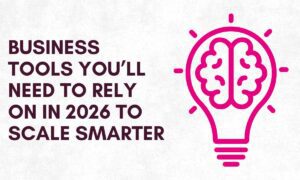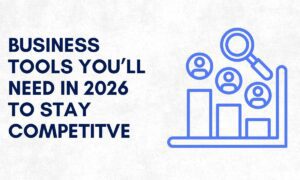Have you ever opened your laptop and suddenly felt like you were being shouted at by 50 different AI tools?
One’s writing your emails. Another is recommending 12 productivity hacks. And somehow, none of it feels like it’s making you smarter, just more mentally scrambled.
So I hit pause and asked myself, how do I think better in a world full of artificial noise?
Well, not to scare you, I hope you know that the global AI market is expected to reach $1.81 trillion by 2030 from the present global market, which is worth $391 billion. That’s an increase of around $195 billion since 2023.
In the rush to integrate AI into everything, from emails and content creation to dashboards and analytics, many people are missing something crucial: “the power of the human brain.”
AI can provide quicker outcomes, simplify processes, and even compose a rather good paper in a little time frame. But if we’re not vigilant, it will also silently take away the one thing we cannot afford to lose: our capacity to think critically.
We run the danger of being ineffective as well. We run the danger of becoming cognitively numb, drowning in templated “personalized” communications, half-processed dashboards, and AI-generated drafts all beginning to seem the same.
The truth is, artificial intelligence’s actual promise is not to inundate us with more. Its goal is to assist us in doing less, deliberately, carefully, and with more clarity. Used correctly, artificial intelligence should lower the cognitive burden rather than raise it. It should enhance our judgment, not weaken it.
So, how do we protect our brainpower while still making the most of this technology?
1. Run a Critical-Thinking Diagnostic on Your Work
Though it’s amazing, AI represents a great risk if we ignore it.
When something goes quickly, we prefer to trust it. We presume the solution must be good because it arrived fast, well packed, and sounded sophisticated. But that’s the trap. The moment we stop probing those responses, we cease thinking. We change from being the pilot to being another passenger, travelling wherever the tool decides to take us.
That’s why it’s necessary to pause and do a brief critical-thinking check on your work. A gut-check to make sure your brain, not the bot, is still directing the vehicle.
Here are a few warning indicators that you could be outsourcing too much of your thinking:
You’re accepting AI responses without modifying them. If every output receives a copy-paste treatment in your process, you’ve probably ceased screening for correctness or relevance.
You can’t articulate the ‘why’ behind your decision. Maybe the dashboard told you to do it. Maybe the chatbot made it sound rational. But if you can’t adequately articulate the logic in your own words, the judgment wasn’t truly yours.
You’re counting on AI to shape your strategy, not simply support it. It’s one thing to employ AI for concepts or drafts. It’s another to let it determine your approach. If you’re bypassing the thinking step and moving right to the output, that’s a red indicator.
This is something Kevin Mann frequently highlights when advising leadership teams: if AI becomes your brain rather than your assistant, you’re not innovating; you’re outsourcing your value.
2. The goal isn’t to ditch AI, it’s to stay in charge of it.
AI’s recent rapid growth is unlikely to slow down shortly. Global AI adoption by organisations is set to expand at a CAGR of 35.9% between 2025 and 2030. Take a look at the chat below showing companies interest some years back and compare it with what we have today.
Use technology to generate ideas, not make decisions for you. Let it handle the hard work so you can focus on the details. Ask it challenging questions. Push back. Revise. Question the argument like you would if a coworker presented you with the same recommendation.
AI is a tool, not a truth machine. It’s fast, yes, but your judgment is the actual value in the process.
So, before you push publish, submit, or approve, pause. Reread the output. Run it through your filter. And make sure it still sounds like something you believe in. That’s what keeps you in the pilot seat.
3. Let AI Handle the Low-Lift Tasks

Let’s be honest, some tasks just sap the vitality out of your day. Repetitive admin job, drafting the same email ten different ways, extracting data for the third weekly report in a row… These tasks don’t need your finest thinking, but they nonetheless take up your mental capacity. That’s exactly the type of clutter AI is meant to clean.
But here’s the catch: a lot of teams make the mistake of chucking everything and anything at AI and hoping for the best. It’s like handing up the wheel without establishing a destination. That’s how you wind up with a torrent of low-effort content, fast, cheap, but forgettable. Automation without purpose.
The key isn’t just to automate, it’s to delegate with purpose.
Here’s a simple step playbook to do just that:
Spot What’s Draining Your Focus
Look at your week and highlight anything that feels mindless or repetitive. Stuff like transcribing meeting notes, writing boilerplate intros for emails, and pulling the same KPI data again and again. If it doesn’t need your unique perspective, it’s probably a good candidate for AI.
Use the Time You Save With Intention
This is the part most people skip. You freed up two hours, now what? Don’t just fill it with more noise. Use that space for strategic thinking, creative problem-solving, or conversations that move your work forward. That’s where your brain shines.
When deployed appropriately, AI not only saves you time, but it also safeguards your energy. It clears the mental clutter so your focus may settle on what matters most. So don’t regard automation as a magic wand. Treat it like a smart assistant, one that takes care of the grind so you can deliver the insight. That’s how you get more done and think better while doing it.
4. Get Curious and Build Your AI Toolkit
To make AI work for you, you don’t have to be a technology expert. Curiosity, the readiness to experiment, try new things, and discover what genuinely improves your thinking, is more important.
The true potential of AI lies in its ability to increase your cognitive abilities rather than merely automate activities. Having the right tools may also be quite helpful, especially if you want to reduce brain overload and free up time for more strategic, in-depth work. If you’re just getting started, don’t feel pressured to use enterprise-level software straight away. You may have a few dependable, reasonably priced, and unexpectedly powerful tools in your go-to stack.
I’ll give advice. See what works. Try, experiment, and identify resources that support your greatest thinking, not simply more of it.
5. Save Space for Real Thought, Not Just Output
AI can be powerful, sure, but if we’re not careful, it can bulldoze the very thing that makes us valuable: our ability to think with depth, empathy, and judgment.
The real risk isn’t that AI will make us lazy, it’s that it’ll keep us so busy producing that we forget to pause and think.
A recent study by IBM shows that 87% of executives surveyed believe employees are more likely to be augmented than replaced by generative AI. That varies across functions, 97% of executives think employees in procurement are more likely to be augmented than replaced, compared to 93% for employees in risk and compliance, 93% for finance, 77% for customer service and 73% for marketing. That’s a massive disconnect. We’re being told to embrace these tools while juggling already full plates, and without support, AI becomes yet another source of pressure, not the productivity boost it promises to be.
Let me give you a real-world example: I once worked with a marketing team where leadership rolled out a suite of AI writing tools almost overnight. The idea was to make content production faster. And it did, on paper. But within weeks, the team was buried in drafts, dashboards, and new deadlines. Creativity dropped. Meetings became robotic. No one had time to reflect, refine, or ask, “Does this even make sense for our audience?” The thinking part, the human part, got lost.
That’s why Wade Younger recommends something so simple but so powerful: carve out intentional space for “human-only” thinking. It can be just two hours a week. No dashboards. No deadlines. Just space to reflect, brainstorm, discuss hard questions, or dive deep into strategy.
And yes, this needs structure. Training should be mandatory, not as a checkbox, but as an investment in your people’s growth. Create “AI champions” within teams who can guide and support, not just instruct. Let learning sprints be part of the culture. Normalise reflection, not just reaction.
Because in the end, the most valuable thinking doesn’t happen at lightning speed. It happens when we slow down enough to listen to ourselves and each other.
Final Thoughts: Your Brain Is the Real MVP, Fuel It Accordingly
While the rush to embrace AI is fascinating, we must not lose sight of the bigger picture. Technology is meant to supplement, not to replace, human thought. We must also tenaciously defend the area where our true worth resides, judgment, insight, creativity, and empathy, while we delegate the menial job.
Setting stronger limits with technology is only one aspect of reclaiming your brainpower; another is treating your mind as the valuable resource that it is. This entails setting aside time for introspection, practising deliberately, and even providing your brain with the proper stimuli.
Yes, what you eat does matter.
Your nutrition should be discussed if you’re serious about improving your cognitive abilities and maintaining mental clarity. Consume nutritious food. Eat healthy food that improves your cognitive function, that is.
Accept the bots, but remember to feed the computer’s brain.
Because your greatest advantage will always be your capaCcity for critical thought, meaning-making, and wise leadership, regardless of how far AI advances.































